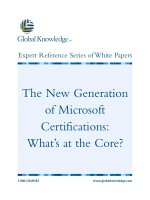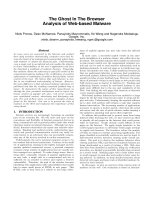ruby on rails the new gem of web development
Bạn đang xem bản rút gọn của tài liệu. Xem và tải ngay bản đầy đủ của tài liệu tại đây (374.91 KB, 31 trang )
Ruby on Rails
::The New Gem of Web Development
Ross Pallan
IT Project Manager
Argonne National Laboratory
2
Ruby on Rails
Ruby on Rails is a web application framework written in Ruby, a
dynamically typed programming language. The amazing productivity
claims of Rails is the current buzz in the web development community. If
your job is to create or manage web applications that capture and
manipulate relational database from a web-based user interface, then
Ruby on Rails may be the solution you’ve been looking for to make your
web development life easier.
In this presentation:
–
Get an introduction to Ruby on Rails
–
Find out what’s behind the hype
–
See it in action by building a fully functional application in minutes
3
Ruby is a pure object-oriented programming language with a super clean
syntax that makes programming elegant and fun.
–
In Ruby, everything is an object
Ruby is an interpreted scripting language, just like Perl, Python and PHP.
Ruby successfully combines Smalltalk's conceptual elegance, Python's
ease of use and learning and Perl's pragmatism.
Ruby originated in Japan in 1993 by Yukihiro “matz” Matsumoto, and has
started to become popular worldwide in the past few years as more
English language books and documentation have become available.
Ruby is a metaprogramming language. Metaprogramming is a means of
writing software programs that write or manipulate other programs
thereby making coding faster and more reliable.
What is Ruby?
4
What is Rails?
Ruby on Rails or just Rails (RoR)
Rails is an open source Ruby framework for developing database-backed
web applications.
Created by David Heinemeier Hansson – DHH Partner, 37Signals
/>
The Rails framework was extracted from real-world web applications.
That is, Rails comes from real need, not anticipating what might be
needed. The result is an easy to use and cohesive framework that's rich
in functionality, and at the same time it does its best to stay out of your
way.
All layers in Rails are built to work together so you Don’t Repeat Yourself
and can use a single language from top to bottom.
Everything in Rails (templates to control flow to business logic) is written
in Ruby
–
Except for configuration files - YAML
5
Rails Strengths – It’s all about Productivity
Metaprogramming techniques use programs to write programs. Other
frameworks use extensive code generation, which gives users a one-time
productivity boost but little else, and customization scripts let the user
add customization code in only a small number of carefully selected
points
–
Metaprogramming replaces these two primitive techniques and
eliminates their disadvantages.
–
Ruby is one of the best languages for metaprogramming, and Rails
uses this capability well.
Scaffolding
–
You often create temporary code in the early stages of development
to help get an application up quickly and see how major components
work together. Rails automatically creates much of the scaffolding
you'll need.
6
Rails Strengths – Write Code not Configuration
Convention over configuration
–
Most Web development frameworks for .NET or Java force you to write pages
of configuration code. If you follow suggested naming conventions, Rails
doesn't need much configuration. In fact, you can often cut your total
configuration code by a factor of five or more over similar Java frameworks
just by following common conventions.
•
Naming your data model class with the same name as the corresponding
database table
•
‘id’ as the primary key name
Rails introduces the Active Record framework, which saves objects to the
database.
–
Based on a design pattern cataloged by Martin Fowler, the Rails version of
Active Record discovers the columns in a database schema and automatically
attaches them to your domain objects using metaprogramming.
–
This approach to wrapping database tables is simple, elegant, and powerful.
7
Rails Strengths – Full-Stack Web Framework
Rails implements the model-view-controller (MVC) architecture. The
MVC design pattern separates the component parts of an application
–
Model encapsulates data that
the application manipulates,
plus domain-specific logic
–
View is a rendering of the
model into the user interface
–
Controller responds to events
from the interface and causes
actions to be performed on the
model.
–
MVC pattern allows rapid
change and evolution of the
user interface and controller
separate from the data model
8
Rails Strengths
Rails embraces test-driven development.
–
Unit testing: testing individual pieces of code
–
Functional testing: testing how individual pieces of code interact
–
Integration testing: testing the whole system
Three environments: development, testing, and production
Database Support: Oracle, DB2, SQL Server, MySQL, PostgreSQL, SQLite
Action Mailer
Action Web Service
Prototype for AJAX
9
Rails Environment and Installing the Software
Rails will run on many different Web servers. Most of your development
will be done using WEBrick, but you'll probably want to run production
code on one of the alternative servers.
–
Apache, Lighttpd (Lighty),Mongrel
Development Environment
–
Windows, Linux and OS X
–
No IDE needed although there a few available like Eclipse, RadRails
Installing Ruby for Windows
–
Download the “One-Click Ruby Installer from
Installing Ruby for Mac
–
It’s already there!
RubyGems is a package manager that provides a standard format for
distributing Ruby programs and libraries
Installing Rails
–
>gem install rails –include-dependencies
1
0
Rails Tutorial
Create the Rails Application
–
Execute the script that creates a new Web application project
>Rails projectname
–
This command executes an already provided Rails script that creates
the entire Web application directory structure and necessary
configuration files.
1
1
App> contains the core of the application
•
/models> Contains the models, which encapsulate application
business logic
•
/views/layouts> Contains master templates for each controller
•
/views/controllername> Contains templates for controller actions
•
/helpers> Contains helpers, which you can write to provide more
functionality to templates.
Config> contains application configuration, plus per-environment
configurability - contains the database.yml file which provides details of the
database to be used with the application
Db> contains a snapshot of the database schema and migrations
Log> application specific logs, contains a log for each environment
Public> contains all static files, such as images, javascripts, and style
sheets
Script> contains Rails utility commands
Test> contains test fixtures and code
Vendor> contains add-in modules.
Rails Application Directory Structure
1
2
Hello Rails!
Need a controller and a view
>ruby script/generate controller Greeting
Edit app/controllers/greeting_controller.rb
Add an index method to your controller class
class GreetingController < ApplicationController
def index
render :text => "<h1>Hello Rails World!</h1>"
end
end
–
Renders the content that will be returned to the browser as the
response body.
Start the WEBrick server
>ruby script/server
http://localhost:3000
1
3
Hello Rails!
Add another method to the controller
def hello
end
Add a template app/views/greeting>hello.rhtml
<html>
<head>
<title>Hello Rails World!</title>
</head>
<body>
<h1>Hello from the Rails View!</h1>
</body>
</html>
1
4
Hello Rails!
ERb - Embedded Ruby. Embedding the Ruby programming language
into HTML document. An erb file ends with .rhtml file extension.
–
Similar to ASP, JSP and PHP, requires an interpreter to execute and
replace it with designated HTML code and content.
Making it Dynamic
<p>Date/Time: <%= Time.now %></p>
Making it Better by using an instance variable to the controller
@time = Time.now.to_s
–
Reference it in .rhtml <%= @time %>
Linking Pages using the helper method link_to()
<p>Time to say <%= link_to "Goodbye!", :action => "goodbye" %>
1
5
Building a Simple Event Calendar
Generate the Model (need a database and table)
Generate the Application
Configure Database Access
Create the Scaffolding
Build the User Interface
Include a Calendar Helper
Export to iCal (iCalendar is a standard for calendar data exchange)
1
6
Create the Event Calendar Database
Create a Database
–
Naming Conventions
•
Tables should have names that are English plurals. For example,
the people database holds person objects.
Use object identifiers named id.
•
Foreign keys should be named object_id. In Active Record, a row
named person_id would point to a row in the people database.
•
ID
•
Created_on
•
Updated_on
–
Edit the config/database.yml
Create a Model
Create a Controller
1
7
Rails Scaffolding
Scaffold
–
Building blocks of web based database application
–
A Rails scaffold is an auto generated framework for manipulating a
model
CRUD Create, Read, Update, Delete
>ruby script/generate model Event
>ruby script/generate controller Event
•
Instantiate scaffolding by inserting
•
scaffold :event into the EventController
•
The resulting CRUD controllers and view templates were created
on the fly and not visible for inspection
1
8
Rails Scaffolding
Generating Scaffolding Code
Usage: script/generate scaffold ModelName [ControllerName] [action,…]
>ruby script/generate scaffold Event Admin
–
Generates both the model and the controller, plus it creates scaffold
code and view templates for all CRUD operations.
–
This allows you to see the scaffold code and modify it to meet your
needs.
•
Index
•
List
•
Show
•
New
•
Create
•
Edit
•
Update
•
Destroy
1
9
Create the User Interface
While functional, these templates are barely usable and only intended to
provide you with a starting point
–
RHTML files use embedded Ruby mixed with HTML ERb
•
<% …%> # executes the Ruby code
•
<%= … %> # executes the Ruby code and displays the result
–
Helpers
–
Layouts
–
Partials
–
Error Messages
–
CSS
–
AJAX
Form Helpers
–
Start, submit, and end forms
2
0
User Interface with Style
Layouts
/standard.rhtml
Add layout "layouts/standard" to controller
Partials
/_header.rhtml
/_footer.rhtml
Stylesheets
–
Publis/stylesheets/*.css
•
NOTE: The old notation for rendering the view from a layout was
to expose the magic @content_for_layout instance variable. The
preferred notation now is to use yield
2
1
Enhance the Model
Enhancing the Model
–
The model is where all the data-related rules are stored
–
Including data validation and relational integrity.
–
This means you can define a rule once and Rails will automatically
apply them wherever the data is accessed.
Validations - Creating Data Validation Rules in the Model
validates_presence_of :name
validates_uniqueness_of :name
validates_length_of :name :maximum =>10
Add another Model
Migrations
–
Rake migrate
2
2
Create the Relationship
Assigning a Category to an Event
–
Add a field to Event table to hold the category id for each event
–
Provide a drop-down list of categories
Create Relationship
–
Edit models\event.rb
Class Event < ActiveRecord::Base
belongs_to :category
end
–
Edit models\category.rb
Class Category < ActiveRecord::Base
has_many :events
end
–
An Event belongs to a single category and that a category can be
attached to many events
2
3
Rails Relationships
Model Relations
–
Has_one => One to One relationship
–
Belongs_to => Many to One relationship (Many)
–
Has_many => Many to One relationship (One)
–
Has_and_belongs_to_many =>Many to Many relationships
2
4
Associate Categories to Events
Edit Event Action and Template to assign categories
def new
@event = Event.new
@categories = Category.find(:all)
end
def edit
@event = Event.find(@params[:id])
@categories = Category.find(:all)
end
Edit _form.rhtml
<%= select "event", "category_id", @categories.collect {|c| [c.name, c.id]} %>
2
5
Calendar Helper
This calendar helper allows you to draw a databound calendar with fine-
grained CSS formatting without introducing any new requirements for
your models, routing schemes, etc.
Installation:
–
script/plugin install />–
List plugins in the specified repository:
plugin list source= />–
To copy the CSS files, use
>ruby script/generate calendar_styles
Usage:
<%= stylesheet_link_tag 'calendar/blue/style' %>
<%= calendar(:year => Time.now.year, :month => Time.now.month) %>









